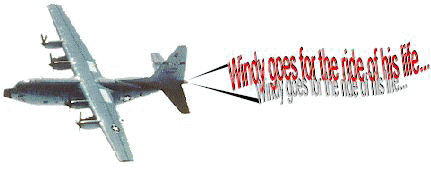

| Hurricane Opal is nearly 300 miles away, so it will take only an hour and a half for us to get there. The first thing we'll do is check our weather instruments. The weather officer looks at the weather instruments and compares their readings with the latest forecast charts and data from weather balloons along the coast. |  |
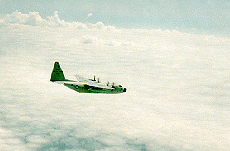 |
As we fly over the Gulf of Mexico toward Opal, the weather is beautiful! It's an odd feeling, knowing that what awaits us is quite different. In Pilot Training, we were always told to stay far, far away from thunderstorms, now they want us to go right through them. We remind ourselves that we all volunteered for this job! |
| "Attention to storm briefing, crew.
Things are about to get busy, so please minimize chatter. The navigator will be directing
the aircraft until we get close to the eye, then Weather will take us in from there, with the Nav backing him up. Copilot, guard the autopilot, and kick it off if we get into severe turbulence. Everyone, make sure all loose items are stowed. We're about to start our descent to 10,000 feet. Oh, make sure Windy has a burp bag!" |
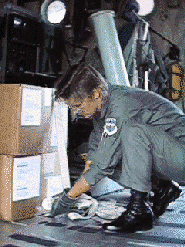 |
 |
Now the airplane has descended to 10,000 feet, and we're 105 nautical miles from the predicted center of Hurricane Opal. The weather officer switches on the High Density Data, which means the airplane is collecting position and weather data every 30 seconds. You look over his shoulder at his computer screen, but it just looks like a bewildering mess of numbers--until he explains how to decode it. Each page of numbers is zapped through a satellite link directly to the computers at the National Hurricane Center, and eagerly studied by the forecasters to see how large and how strong the storm is. |
Now the real fun begins. The weather officer looks down at the churning seas below, and estimates the strength of the wind by how the water looks. White caps, patches of foam, spray: each hint at the power of the furious winds spiraling around this dangerous hurricane. The navigator asks the pilots to swerve around a particularly nasty thunderstorm--no need to tempt fate at this stage of the game. The engineer sweeps his eyes across the maze of gauges on the panels in front of him and over his head, and assures himself that this plane is working right, ready for the furious weather ahead. The dropsonde operator makes one final inspection around the cargo compartment, checking that everything is tied down tightly, and no leaks have sprung up from the hydraulic systems. And the pilots review their strategy to tackle this monster. |
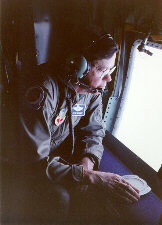 |
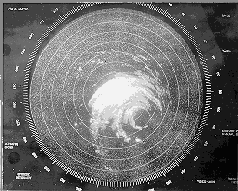 |
The navigator calls out that he sees the eye on radar. There are spiral bands of thunderstorms wrapping around a bright ring surrounding a clear spot on radar. The bright ring is called the "eyewall" and is a solid ring of thunderstorms, containing the most violent weather in the storm. It looks so small on the scope, but the navigator assures you the tiny clear spot is 15 miles across, and the eyewall is 20 miles away! |
| "We're five miles from the eyewall." announces the navigator. Heavy rain begins to pelt the airplane, and sheets of water wash over the windows. It gets darker, and turbulence begins to rock the plane. It's hard to walk back to your seat, but the Dropsonde Operator assures, "You ain't seen nothing yet!" |  |
 |
"We're about to penetrate the eyewall; everyone strap in," commands the pilot. Just as you finish snapping your seatbelt closed, you're thrown violently against your straps. You get that "funny feeling" in your stomach as the plane free-falls 1000 feet, and you feel nearly weightless for a moment. Through the deafening noise of surging propellers and pounding rain, you think you hear someone yell "Yee-hah!" Suddenly, the plane seems to buck in every direction at once, and a brief flash of lightning breaks through the darkness. |
| After what seems like an eternity (was it really just three minutes?), the dark gray clouds outside the window begin to brighten, and suddenly blinding white light stings your eyes. The hiss of heavy rain shuts off in the same instant. One or two sharp bumps, and the plane flies smoothly again. You're not sure you've ever felt your heart pound so hard, but you survived...you're in the eye! |  |
 |
As your eyes adjust to the glare of sunlight, you gaze out at one of the most awesome scenes in nature: the "stadium effect" inside the eye. A solid wall of clouds circles around the WC-130, as though you are floating in a giant football stadium made of clouds. You are inside a giant well that opens up miles above your head into a bright, blue sky. Congratulations...you've just joined an exclusive group: those few people who have entered the eye of a hurricane. |
| Back to Windy's Room | Continue your flight |